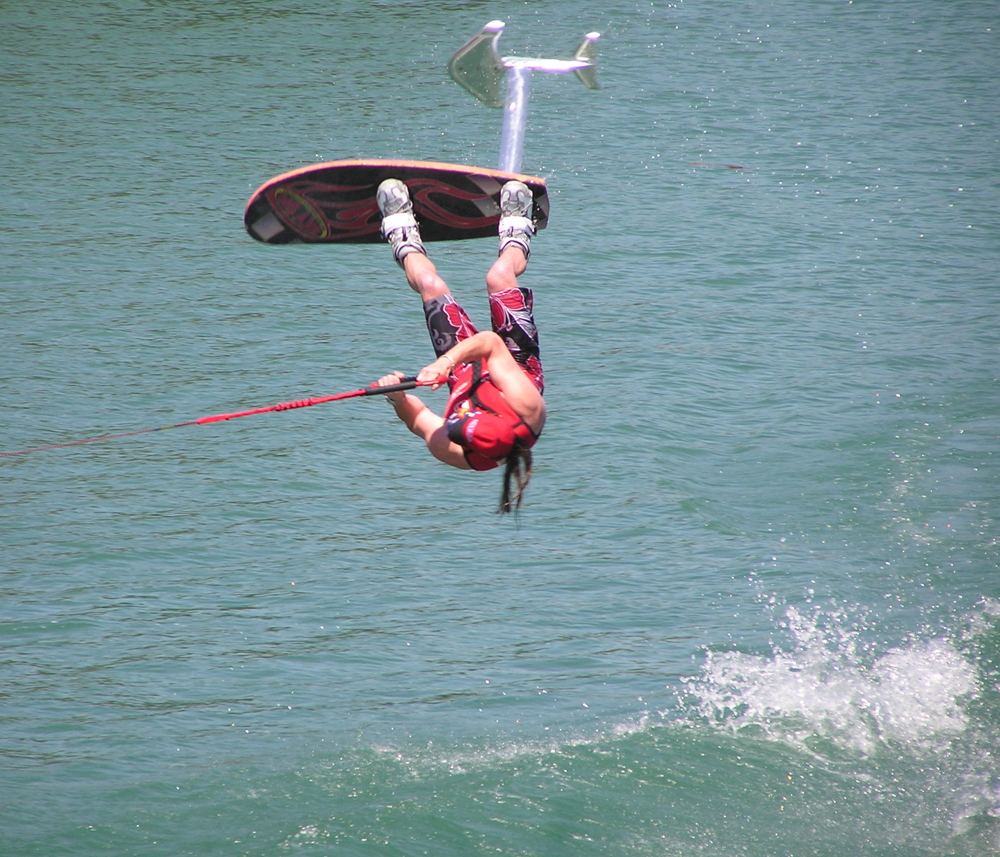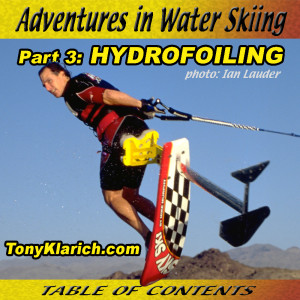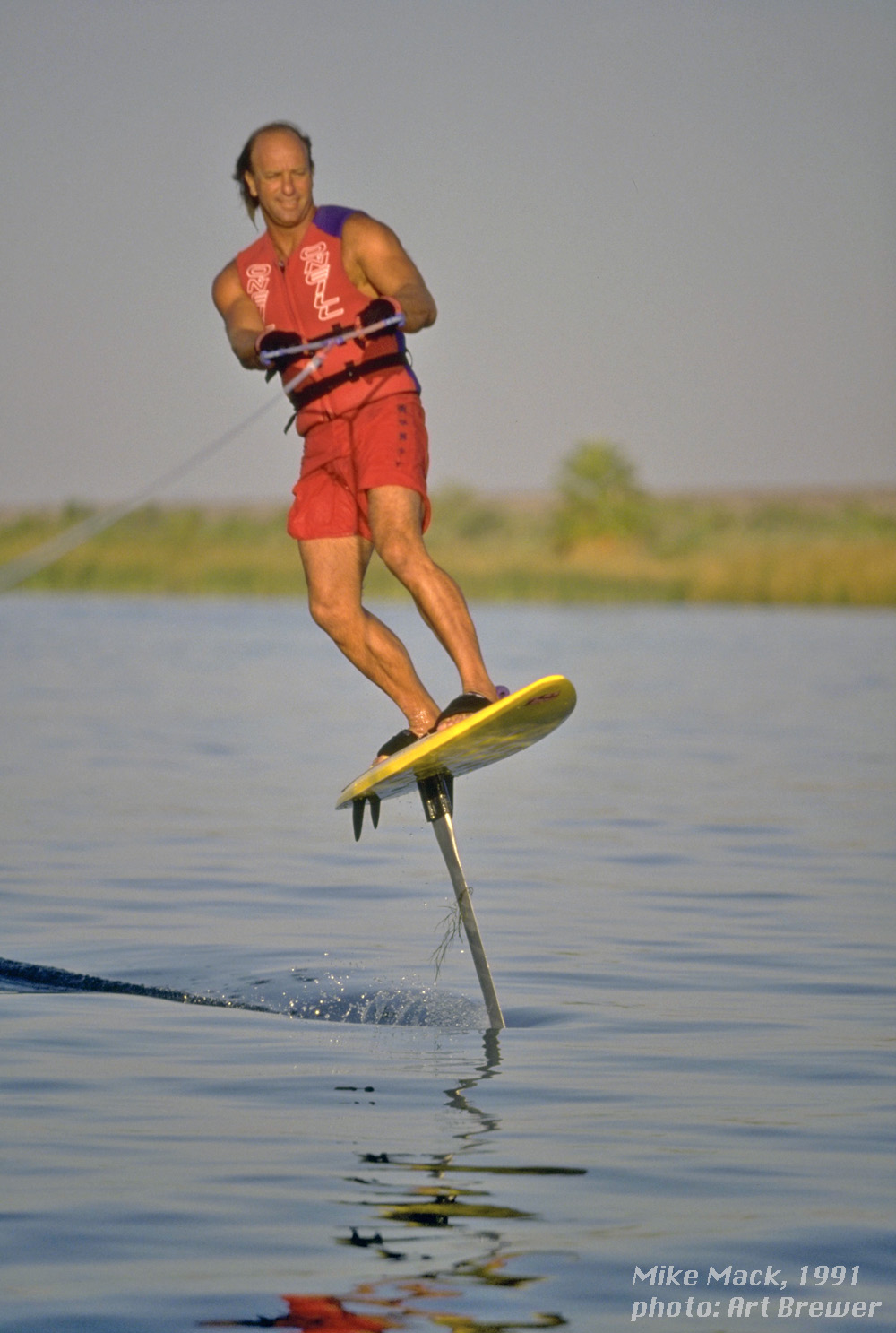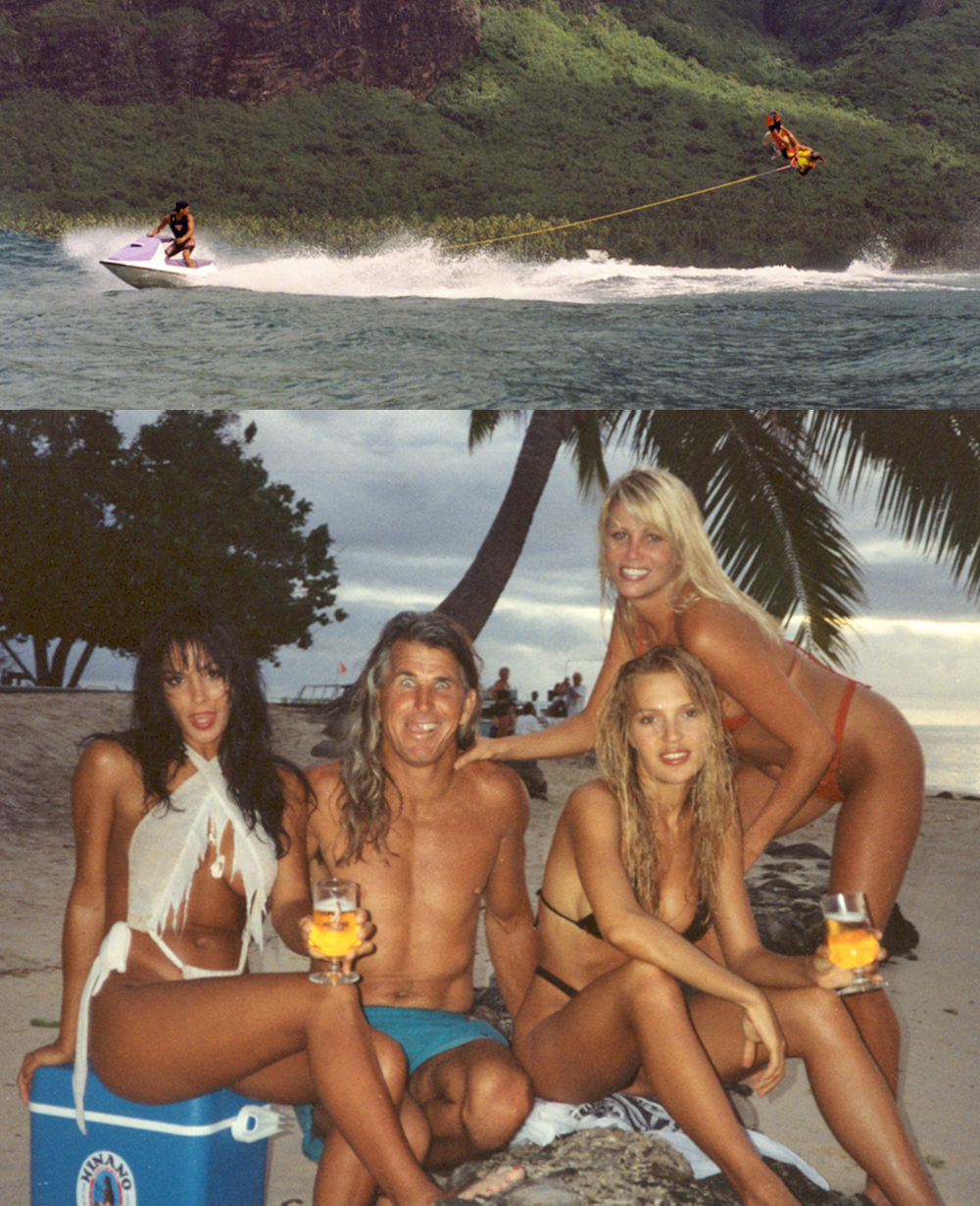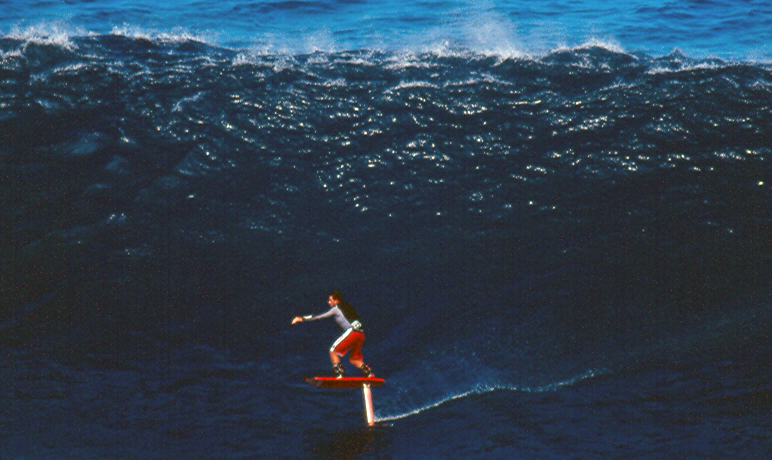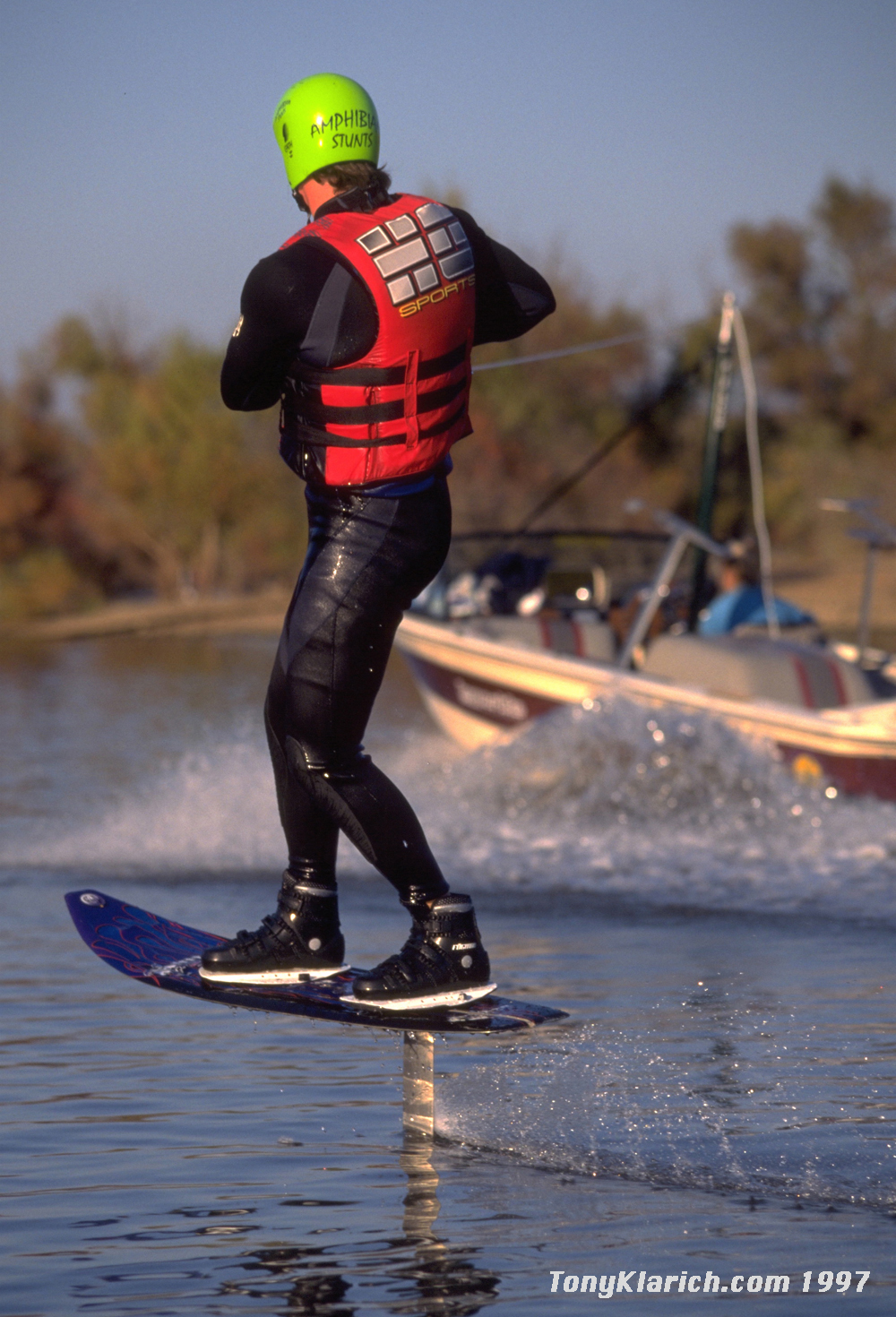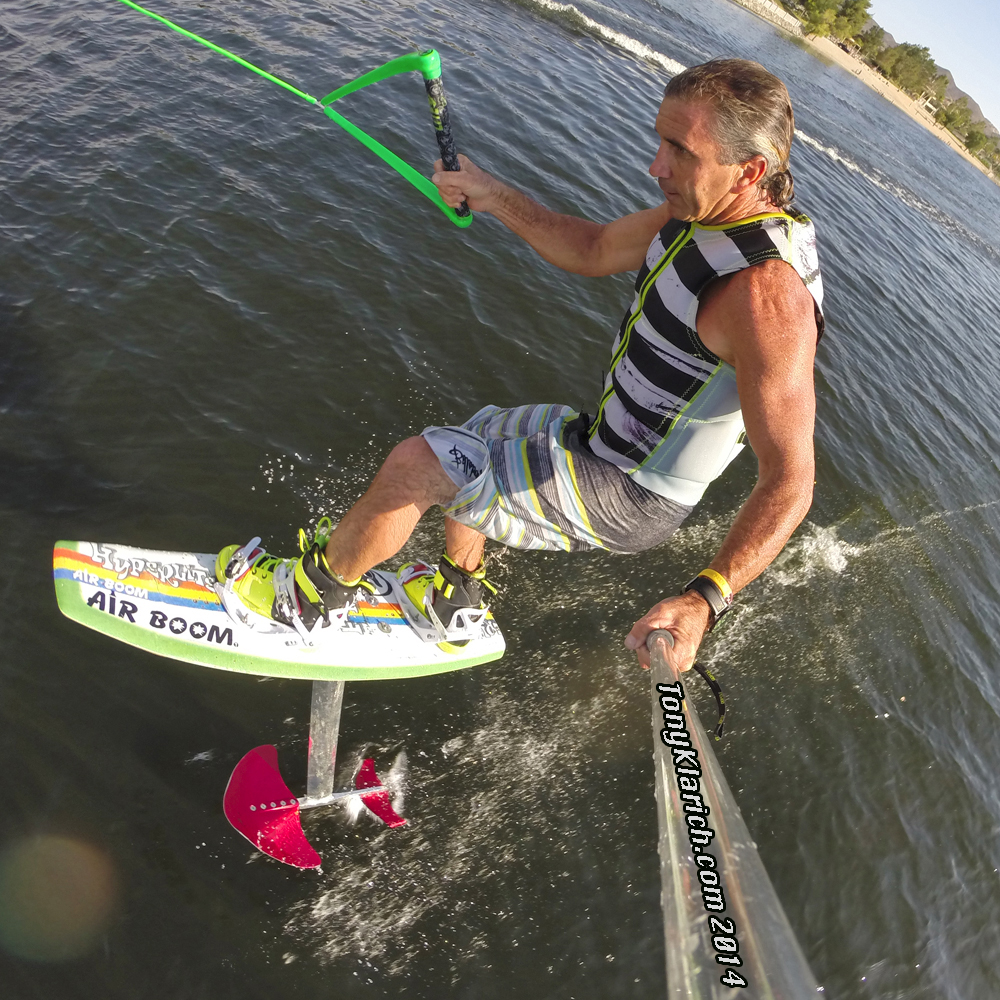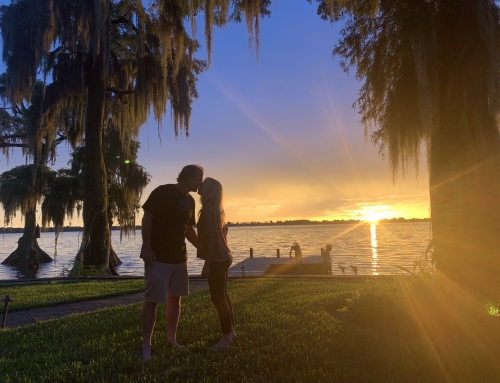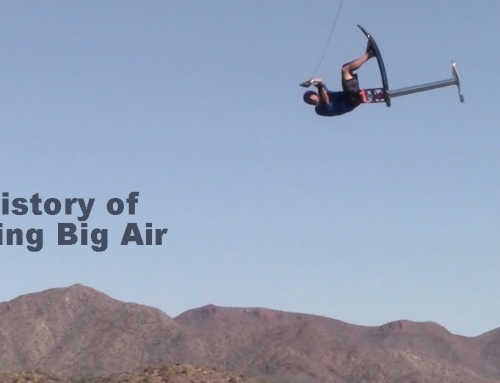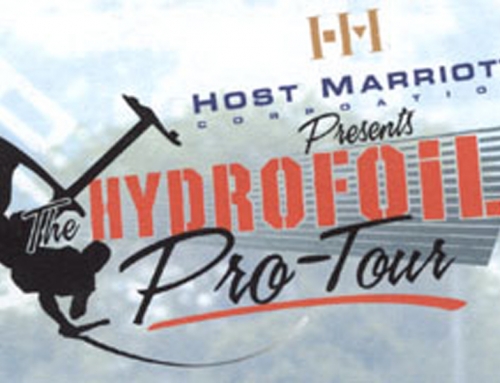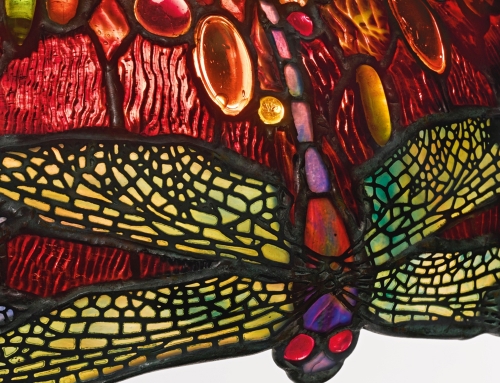STAND UP GUYS
The first time I ever saw a stand up foil ridden like a wakeboard was in 1991 at Mike Mack’s place on the Parker Strip[i]. Mack took a foil assembly from an Air Chair and mounted it to a Rusty surfboard. His first model did not have footstraps or bindings, and it was quickly apparent that it needed something to keep his feet on the board. So Mack added a set of neoprene bindings to create the “air board.” I got to ride his first board with foot straps, and was able to get up right away. It was a thrill to be one of the first ones to pioneer another new device in water skiing. While I did enjoy it, I never got comfortable. It was touchy to control, but the biggest problem was that you could come out of it, just like the early days of Air Chair before the seat belt and heel straps. The new stand up foil was dangerous, so Air Chair sent out “cease and desist” letters to Mike Mack and Troy Navarro (Troy was an early pioneer in wakeboarding who also worked on his own air board[ii]). Mack dutifully put his air board in storage, and turned his creative energies to projects that did not result in a letter from a lawyer.
Mike Mack on his original air board. (Brewer, 1991)
Meanwhile, the next step in the development of the stand up foil board came from Mike Murphy during a photo trip with the Hawaiian Tropic bikini girls. Mike’s friend Jeff Clair was scheduled to be the cameraman for a video shoot in Hawaii and Tahiti. Air Chair was in the process of making a promo video, and Mike asked if he could tag along with Jeff to get some film while riding in the exotic locales. The result was Mike’s best footage riding a hydrofoil. The water was crystal blue, Mike was looking sharp in an orange and yellow Body Glove wetsuit, and he was at the peak of his riding.
Mike and the Hawaiian Tropic girls in Tahiti. (Dunham, 1996)
Jeff Clair’s video shoot in Tahiti was for various projects, but one of them was for a new TV show called The Extremists. When Casey Bennett, producer of The Extremists, saw Mike’s footage, they ended up doing a story on Mike and the Air Chair. Mike’s video segment on the popular 1990s TV show got him a round of requests for more appearances.
The Extremists asked Mike to travel to Cypress Gardens to do a story on wakeboarding and hydrofoiling with Zane Schwenk, Geno Yauchler and big wave surfer Laird Hamilton. Mike ended up teaching Laird how to ride the Air Chair as part of the story.
The hydrofoiling–surfing connection continued when Laird’s wife Gabrielle Reese became the permanent host of The Extremists, and came out to Mike Mack’s place on the River to get a hydrofoiling lesson of her own. Murphy gave the lesson, giving Gabby step-by-step instruction so she didn’t get “cornfused.”
When Laird got back to Maui he hooked up with Rush Randle and Brett Lickle, who already had an Air Chair. The guys learned to fly the Air Chair behind their sit down PWCs, which they normally used for tow-in surfing. These three watermen were surfers at heart, so it wasn’t long before they all tried to ride the Air Chair by straddling the seat in an upright surf stance. They saw possibilities for standing and riding, and headed back to Laird’s shop to cut off the seat tower and add footstraps.[iii] In the months that followed the footstraps became quick release snowboard bindings, and the Air Chair deck was replaced by a wakeboard. As the trio advanced they shaped a board specifically for the new sport: foil boarding. The addition of snowboard boots was the main reason the Hawaiian group never got a cease and desist letter from Air Chair. Riders stayed firmly connected to the board, unlike the first stand up air boards from Mike Mack and Troy Navarro. In those days Murphy was still at Air Chair, and he provided Laird and Rush with foils to use as they developed their new foil boards.
Laird and company were also in the midst of developing tow in surfing, so once the guys learned how to ride the foil board behind the PWCs it was always their intention tow into waves with a foil board and ride without the rope. With this group of innovators it was a no brainer to tow into waves on a foil board.
The original group of three men broke up after about a year, and each continued to ride. The foil board was faster than a surfboard as it rode above the chop in rough surface conditions. Laird got a ton of coverage riding his foil board, and was often seen with David Kalama towing into waves that couldn’t be ridden on anything else.
Rush went on to manufacture his own foil boards, and backed up his brand with a claim of a 10-mile ride on a 20-foot ocean swell that lasted for 15 minutes. In later years Rush pioneered the loop while riding a wave. He jumped, got completely inverted on a roll, and caught his balance on the landing to continue riding. It became so automatic that he was eventually able to land several loops on a single wave. When Mike joined Rush in Hawaii in the late 1990s to try some tow-in riding too, but Mike’s used a Sky Ski. After just a few sets Mike was right there throwing rolls of his own and riding away using nothing but the power of the wave. I have no doubt these moves were made, but would still love to see some video!
Rush Randle on a foil board at Jaws. (Aeder, 2003)
Foil Surfing with Laird Hamilton, 2003
The foil boarding genie was out of the bottle, and in 1997 Mack pulled his out of storage after seeing Laird on TV. That meant that I got to ride it again too, and I always took a ride or two whenever we went to the River.
In 1997 Ron Stack also turned his attentions to the air board. He made his own ride by welding a flat rectangle to the top of a shortened Sky Ski t-bar so it could be mounted onto a regular compression molded wakeboard. He used the Shapiro pro model that was black, with purple flames.
I rode Ron’s new air board, but was uncomfortable with his binding set up. At that time slalom skiers were just beginning to experiment with hard shell boots, and I thought they could be just thing to improve the connection to the Air Board. So I bought a pair, which were modified in-line skating boots, and mounted them to the aluminum Air Shock plate by Hyperlite. With this set up I was able to have a secure connection to Ron’s air board, and easily mount them in any of the standard positions used for wakeboard bindings.
I took a few rides on Ron’s foil boards (Kingman, 1997)
The big tricks for us at that time were wake-to-wake jumps, skidders, and even combo jumps. One of my favorite moves was a big backside jump in the flats with a method grab. Of course we were dreaming of a flip or helicopter, but that was a lot of hardware to swing around by nothing but your feet and ankles.
Ron’s next board was the best one I have ever ridden. He thought that having the foil mounted under his rear foot was making him work too hard. His back leg got tired quickly, and it was not the right positioning to control the board equally with both feet. He thought it would be much better to mount the foil between the feet. But because the wings still needed to be under the rear foot, he slanted the t-bar at a 45-degree angle. He used a fiberglass front wing, and lighter weight aluminum for the foil assembly. The foil worked great and it was the lightest air board either of us had ever ridden. I rode for many hours on that board, training to use it for the 1999 World’s Greatest Skier Competition at Cypress Gardens.
Ron “airboom” Stack jumping on a board with an angled strut, 2014
Ron tried quite a few wake backside rolls, and came around on the board many times. He never was able to ride one away. I tried a few too in 1999, but couldn’t get over my serious concern for the possibility of breaking a leg. It seemed to me that having so much weight strapped to just my ankles was an accident waiting to happen. There was so much swing weight and leverage that the possibility of injury was always in the back of my mind whenever I rode. Riding with fear is not a good thing, and I stopped trying to be the first one to flip the air board. Giving up on the trick was a shift in thinking about how I rode. It was time to consider the risk to reward ratio for each new move on my to do list. It would be great to have been the first to land it, but the risk of injury was not worth the minimal reward to me. I already had many breakthrough moves under my belt, and adding one more was not worth it.
Laird was getting huge media coverage riding his foil board (that’s what the surfers called it), and uncle Mike wanted to try and capitalize on it. No one was manufacturing a board for riding behind the boat. Mike’s new product was a Sky Ski that could convert into a stand up foil board. The “Convertible” from Sky Ski did exactly what it promised, but most riders ended up fixing their board in the sit down position. The few who stood kept their board set up that way. The Sky Ski Convertible air board was specifically for water-skiing, the surf style foil board had to have an entirely different board design. Rush Randle started offering surf style boards to adventurous riders. But behind the boat or towing in to waves, the stand up foil board was a super niche product that failed to gain any real consumer support in the early days. It was something cutting edge for extreme riders, but not something for the average Joe.
VIDEO LINK:
Rush Randle foil boarding in Billabong Odyssey movie, 2003
While I had given up on flipping the foil board because of a low risk to return ratio, Jake Kinnison had the incentive to go for it. The Convertible was a Sky Ski product that needed promotion, and Jake was second in command at Sky Ski. He was a top performer on the sit down foil, but had yet to establish himself with a really big move of his own. But Jake’s final motivation was an attack on his pride. He usually rode the Convertible with Scott Honkala and Bobby Taylor who urged Jake on by calling him a “pussy” at every opportunity. In February of 2002 Jake finally “grew a set” and threw his first attempts. He came very close to riding away from his first one, but it took him about 100 tries to finally ride one out at the Tennessee Fly-In in June of that year. I was glad for Jake. It was a pretty big deal at the time. Being one of the top air boarders also helped to get him an invite to our big Moscow Ski show the following year.
Jake rolling the Sky Ski Convertible. (Cassano, 2006)
Jake Kinnison riding foilboard, 2002
Jake’s riding partner Bobby Taylor also busted out with his first big move. As a drag racing driver he was no stranger to risk. He worked for months to land the first helicopter on the air board. The crashes were brutal. Catching the foil in the sideways position was the worst. But Taylor persisted and added to the growing list of new tricks.
Rush Randle (air back roll) and Bobby Taylor (helicopter) foilboarding, 2003
In the 2010s the foil board has had a resurgence in kiteboarding. The decreased drag of the foil requires less wind to power the rider, and it cuts through chop like a hot knife through butter. It looks like uncle Mike may be back in the game again with the foil board, this time helping to develop them for the kite surfing community.
VIDEO LINKS: Kite Foiling
2013 kite foil board video “I Believe I Can Fly”
Adam Koch talks kite foil boarding
>Adventures in Water Skiing: SERIES LINKS
Images (used with permission) / References
“Adventures in Water Skiing: Part 3, Hydrofoiling – Cover,” photo: Ian Lauder, 1999.
[i] “1991 – Date Stamped Original Slide,” photo: Art Brewer
[ii] “Troy Navarro on Air Board,” WaterSki Magazine, April 1992, 12.
[iii] Interview with Rush Randal, 2008
Some Rights Reserved. The TEXT ONLY of this publication MAY be used or reproduced in any manner whatsoever without written permission. All use MUST be accompanied with the attribution: “From Adventures in Water Skiing: Part 3, Hydrofoiling. Used with permission by http://tonyklarich.com”. TEXT ONLY is licensed under creative commons agreement (CC BY 3.0). The images (photos) MAY NOT be used, uploaded, reposted, or reproduced in any manner whatsoever without written permission.
